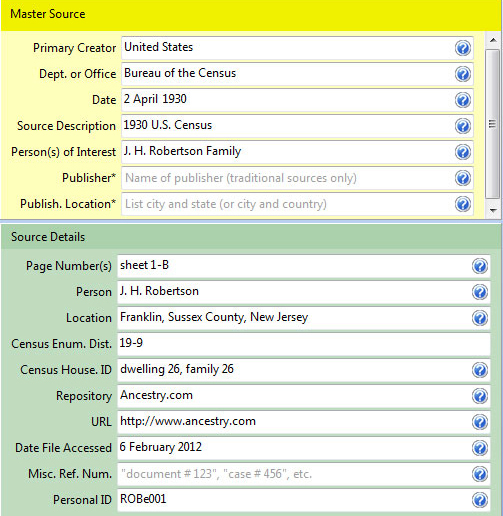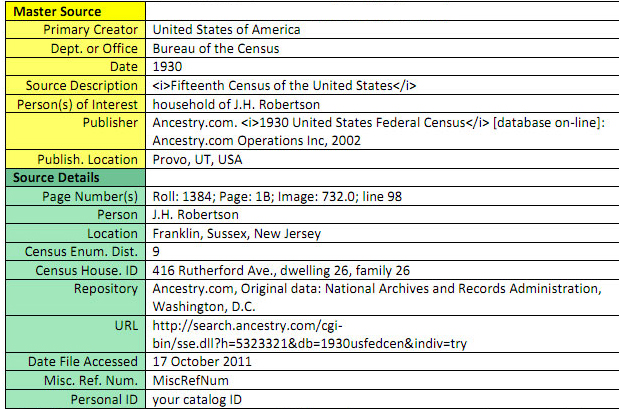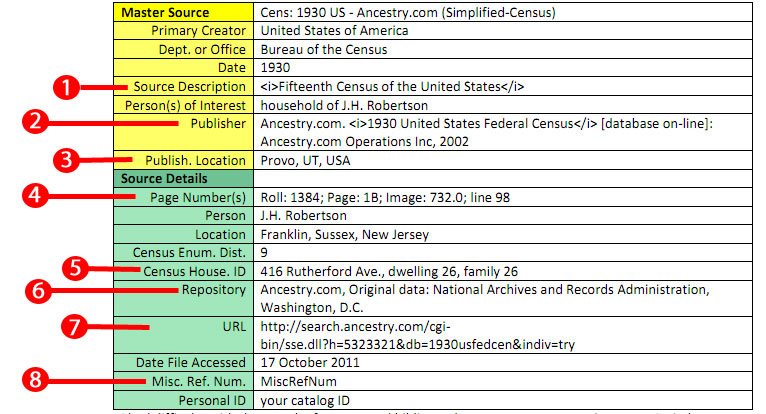Commentary on Tom Holden's MyFreeForm "Study"
Sadly, I initially created this site to counter an unfounded attack on Simple Citations that first appeared shortly after it had been developed and shared. At first, I was very flattered to learn that another RootsMagic user, Tom Holden, had decided to conduct a "study" on "A Trio of Source Templates (compared) But Only One Really Sings!" (It should be noted that this is the actual title that Mr. Holden gave to his "study" - apparently, he's now removed this title and the link is now dead.) The problem is that Mr. Holden compared Simple Citations to a template that he created, !MyFreeForm3, and also with one that is based upon the book Evidence Explained!. Rather surprisingly, Mr. Holden proclaimed that his own template is "the one that sings" and states that his so-called "study,"
"prove[d] that !MyFreeForm3 is overall superior, given the current state of RootsMagic 5. And, yes, I'm probably biased, but I hope it is objectively so."
(Note, Mr. Holden removed his statements that his template is the "only one that really sings," after this criticism was pointed out. The version that he replaced it with may still be found here.)
Personally, I would never have audacity to conduct a "study" of my own templates (Simple Citations), compare it to others that simply are not compatible with it, and then declare them to be "superior" to the others. As previously noted, this site was originally created to dispel the egregious and absolutely unfounded claims by Mr. Holden used to attack Simple Citations. With that in mind, I'll let others decide which approach they feel is "superior."
Perhaps one of Mr. Holden's most outlandish statements regarding the content should be required in a citation occurs at the very beginning (top of p. 3) of his "study,"
"Now I think the Ancestry Source Information, Source Citation and Record URL taken together is comprehensive and, by and large, complies with the principles of Evidence Explained for content, even though it is not necessarily in a pattern corresponding to any one of the built-in source templates or either of the custom templates tried in this report. There is sufficient information for someone else to be able to find the source data and image. The challenge is to fit this information into each source template in such a way that the various outputs from RootsMagic are sensible and usable."
In other words, Tom Holden completely ignores everything about Simple Citations by superimposing Elizabeth Shown Mills Evidence Explained (EE) approach to citations upon it. As noted elsewhere, Simple Citations takes an completely different approach than that taken by Evidence Explained and Tom Holden's imposition of another system upon it is the fatal flaw in his "study."
Another significant problem with Tom Holden's "study" is that he compares apples with oranges. Simple Citations was created to consistently cite sources with the minimal amount of effort; it is clear that Tom Holden's template is not concerned with that at all. In fact, he doesn't appear to be concerned with content and then grossly misrepresents the entire purpose of Simple Citations. The only reason that Simple Citations was created was to address the need to avoid complex decisions when selecting specific information to include in citations. This is the antithesis of any "free form" citation system (which is what !MyFreeForm3 is). By design, free form templates require users to make decisions about EVERYTHING they include. A discussion of the many problems inherent in Mr. Holden's MyFreeForm template may be found here.
As already noted, the reason I originally put up this site is that Mr. Holden incorrectly implements Simple Citations in his "study." He states that he "tried to follow the [Simple Citation] hints [embedded in the RootsMagic template] as closely as possible and, yet, incorporate all the vital information." However, even a cursory look at his example shows that he completely failed to do so and that he infers outlandish claims that ignore what Simple Citations really is: a citation system designed specifically to document genealogical sources. For the sake of argument, I'm going to use the same census record that he used in his "study" - the correct usage of Simple Citations is listed below and is followed by Mr. Holden's example:
Correct ExampleThe example on the right displays the correct use of Simple Citations to enter information found on a U.S. Census record. |
 |
Tom Holden's
|
 |
As the above example attests, there are many differences between the manner in which Simple Citations should be used and Mr. Holden's attempt to "incorporate all the vital information" into one of the Simple Citation templates. This is the first serious (and fatal) flaw in his "study." Specifically, Simple Citations was never intended to include every specific detail that's associated with a document. To his credit, Mr. Holden correctly notes that within the genealogy community there are "lumpers" and "splitters"; however, he appears to have confused the terms. Generally speaking, "lumpers" believe that only the most relevant information needed to locate a source should be included in a citation. Splitters, on the other hand, are obsessed with every little detail (okay, so I'm now showing my own bias). Simple Citations has many "lumper" tendencies and, therefore, less is usually more. The amount of information included in Mr. Holden's example, however, clearly displays splitter tendencies that is contrary to the design of Simple Citations. The following analysis of his example will examine why:
Tom Holden's Incorrect Use of Simple Citations |
 |
The above example displays the incorrect use of Simple Citations in Tom Holden's "study" and is explained further below:
- Source Description: As per the default example on the template, this record should be listed as "1930 U.S. Census." While the above example is not incorrect (as long as the user is consistent), "Fifteenth Census" is meaningless for many people. In addition, the use of tags (e.g., <i> and </i>) should NEVER be used with Simple Citations as formatting is embedded in the RootsMagic template! (Punctuation is also embedded in the template.)
- Publisher: As in noted in the "hints," (that Tom Holden claims to have read but didn't), this field should have been left blank. Furthermore, even if a publisher's name is required (which would only occur very rarely if the census record had been obtained from a printed book, magazine, or other traditional source), the title, information about the database, the appearance of "Ancestry.com Operations, Inc.", and the year (2002), should never been included in this field.
- Publisher Location: Again, according to the "hint" provided on the template, this field should have been left blank. A location should only be listed if the census record was obtained from a book or other printed source.
- Page Number(s): Again, there is far too much (and unnecessary) information included in this field! The only information should have been is "sheet 1-B". The roll, image, and line number cannot be considered as a "page number" and should, therefore, have been excluded.
- Census House, ID: Although it's possible to include the house or street address, as per the hint displayed on the template, only the dwelling and family number are needed (even now, I'm debating if this information is really necessary in a citation).
- Repository: Nothing more than "Ancestry.com" should have been listed. This census record was not obtained (directly) from the National Archives (NARA). The location of NARA is also completely unnecessary and should not have been included.
- URL: Although the full URL may be appropriate, I'm now using only the home page of sites where a document is located (e.g., http://www.ancestry.com) as many on sites, particularly those requiring subscriptions, the actual URL is not available. This happens with the URL Mr. Holden used: http://search.ancestry.com/cgibin/sse.dll?h=5323321&db=1930usfedcen&indiv=try@gss=pt
- Misc. Ref. Num.: I have now used Simple Citations for more than two years and have only used this field with a few citations. It is quite possible that it will be removed in the future.
It should now be evident that the example used in Mr. Holden's "study" did not follow the conventions required by Simple Citations and is, in fact, needlessly complex and contains information (including formatting codes) that should have NEVER been included. To put it bluntly, Mr. Holden did not read the instructions and he misrepresented Simple Citations.
Suggestions for Future Versions of RootsMagic
One of the most important components of Simple Citations is that only the information needed to find the source again should be used. One of the problems inherent in the current RootsMagic template system is that there is no way to notate that some fields are REQUIRED, while other fields are OPTIONAL. While the three Simple Citation Templates are all based upon one master template, some fields must be entered. In the above example, the following fields must be used:
- Master Source
- Primary Creator
- Date
- Source Description
- Person(s) of Interest
- Source Details
- Person (this is usually required but not always)
- Location (again, this is usually required, if possible)
The other fields are optional, although they're useful in most cases. Additional information should not be included and formatting commands should never be used.
Which is the "Best" System?
I make no claims that Simple Citations is the "best" or "superior" - that decision up is left up to those who decided to try it. I will say that at the time this was written, I had used it for more than two years and, for the first time in 30 years, I remain content with the way that sources are cited. I hope that it helps make life a bit easier for others too. The most important thing in documenting a genealogy is to cite all sources consistently. I hope that Simple Citations works for you.
